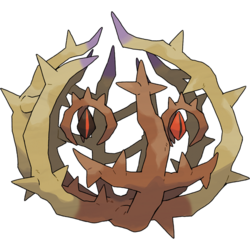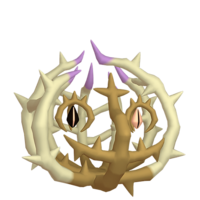From Bulbapedia, the community-driven Pokémon encyclopedia.
Brambleghast (Japanese: アノホラグサ Anohoragusa) is a dual-type Grass/Ghost Pokémon introduced in Generation IX.
It evolves from Bramblin when leveled up while outside of its Poké Ball after the player walks 1000 steps using the Let's Go! feature.[1][2]
Biology
Brambleghast is a tumbleweed-like Pokémon that is similar to its pre-evolution Bramblin, only larger and with more thorns. Most of the branches that compose its loose, spherical body are brownish yellow with light purple tips on top, while the base of its body and its center front branch are entirely dark brown.
The center front branch has two smaller branches near its base, which together with Brambleghast's eyes form a face. The two smaller branches act as Brambleghast's "lips", which can move to form expressions such as grinning or frowning. Brambleghast has small, diamond-shaped, leaf-like eyes; the right eye is black with a thin red pupil, and vice versa for the left eye. Each eye is surrounded by what appears to be a much smaller tumbleweed made of three stalks. The eyes don't blink and instead flip and rotate to express Brambleghast's emotions.
Brambleghast catches prey using its branches, completely enveloping them. Once accomplished, it will not let go of the prey until all of its life energy has been drained. Brambleghast lives in arid regions such as deserts, where the wind tumbles and rolls it around. There are rare occasions of massive outbreaks of Brambleghast, which can bury entire towns.
Evolution
Brambleghast evolves from Bramblin.
(For specifics on this Pokémon's evolution in the games, refer to Game data→Evolution data.)
Game data
Pokédex entries
| This Pokémon was unavailable prior to Generation IX.
|
| Generation IX
|
|
Paldea
#243
|
|
Kitakami
#—
|
|
Blueberry
#—
|
| Scarlet
|
It will open the branches of its head to envelop its prey. Once it absorbs all the life energy it needs, it expels the prey and discards it.
|
| Violet
|
Brambleghast wanders around arid regions. On rare occasions, mass outbreaks of these Pokémon will bury an entire town.
|
|
|
Game locations
| This Pokémon was unavailable prior to Generation IX.
|
|
|
In side games
Held items
Stats
Base stats
| Stat
|
Range
|
| At Lv. 50
|
At Lv. 100
|
55
|
|
115 - 162
|
220 - 314
|
115
|
|
108 - 183
|
211 - 361
|
70
|
|
67 - 134
|
130 - 262
|
80
|
|
76 - 145
|
148 - 284
|
70
|
|
67 - 134
|
130 - 262
|
90
|
|
85 - 156
|
166 - 306
|
Total: 480
|
Other Pokémon with this total
|
- Minimum stats are calculated with 0 EVs, IVs of 0, and (if applicable) a hindering nature.
- Maximum stats are calculated with 252 EVs, IVs of 31, and (if applicable) a helpful nature.
|
Type effectiveness
| Under normal battle conditions in Generation IX, this Pokémon is:
|
|
|
|
|
|
|
|
|
|
|
|
|
Learnset
|
|
|
|
- Bold indicates a move that gets STAB when used by Brambleghast
- Italic indicates a move that gets STAB only when used by an Evolution of Brambleghast
|
|
|
|
|
- Bold indicates a move that gets STAB when used by Brambleghast
- Italic indicates a move that gets STAB only when used by an Evolution or an alternate form of Brambleghast
|
|
|
|
|
- Moves marked with an asterisk (*) must be chain bred onto Brambleghast
- Bold indicates a move that gets STAB when used by Brambleghast
- Italic indicates a move that gets STAB only when used by an Evolution of Brambleghast
|
|
|
|
|
- Bold indicates a move that gets STAB when used by Brambleghast
- Italic indicates a move that gets STAB only when used by an Evolution of Brambleghast
|
Side game data
Evolution data
Sprites
| This Pokémon was unavailable prior to Generation IX.
|
|
|
In the anime

Brambleghast in the
animeMajor appearances
Brambleghast made its main series debut in HZ035, under the ownership of Shine after evolving from a Bramblin.
Minor appearances
In the manga
In the TCG
- Main article: Brambleghast (TCG)
Trivia
Origin
Brambleghast appears to be based on tumbleweeds — certain types of plants which, when mature, have most of their cells dry out and die so that the wind can pick them up and allow them to disperse their seeds, hence Brambleghast's Ghost type and Ability. Some tumbleweed species are capable of causing outbreaks, like the hairy panic. Brambleghast's secondary Ghost type may also be derived from the association of tumbleweeds with ghost towns and empty deserts. The way it feeds on its prey by enveloping them inside and releasing them after fully consumed may be inspired by the feeding habits of jellyfish and other cnidarians.
Name origin
Brambleghast may be a combination of bramble and aghast.
Anohoragusa may be derived from the phrase あのほら草 ano hora kusa ("Um... Look! Grass") and horror.
In other languages
| Language
|
Title
|
Meaning
|
 Japanese Japanese
|
アノホラグサ Anohoragusa
|
From the phrase あのほら草 ano hora kusa and horror
|
 French French
|
Virevorreur
|
From virevoltant and horreur
|
 Spanish Spanish
|
Brambleghast
|
Same as English name
|
 German German
|
Horrerba
|
From horror and Latin herba
|
 Italian Italian
|
Brambleghast
|
Same as English name
|
 Korean Korean
|
공푸리 Gongpuri
|
From 공포 (恐怖) gongpo and 풀 pul
|
 Mandarin Chinese Mandarin Chinese
|
怖納噬草 / 怖纳噬草 Bùnàshìcǎo
|
From 怖 bù, 納 / 纳 nà, 噬 shì, 草 cǎo, and 不,那是草 Bù, nà shì cǎo
|
 Cantonese Chinese Cantonese Chinese
|
怖納噬草 Bounaahpsaihchóu
|
From 怖 bou, 納 naahp, 噬 saih, and 草 chóu
|
|
|
|
| More languages
|
 Hindi Hindi
|
हॉरोग्रास Horrograss
|
From horror and grass
|
 Thai Thai
|
อาโนะโฮรากุสะ Anohorakusa
|
Transcription of Japanese name
|
|
|
|
Related articles
Notes
External links

|
This Pokémon article is part of Project Pokédex, a Bulbapedia project that aims to write comprehensive articles on each Pokémon species, as well as Pokémon groups and forms.
|

 For other sprites and images, please see Brambleghast images on the Bulbagarden Archives.
For other sprites and images, please see Brambleghast images on the Bulbagarden Archives.





